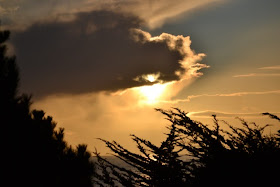Bettye Winters regularly walks the north end of Manchester State Park Beach with her dog, Hunter. This is what Bettye had to say, “This morning there was another first waiting for me. I’ve never come across a shark on our beach. It was small and still alive. I put Hunter on a down/stay. I tried to get it back in the water by rolling it with a big stick but it would just get washed right back to the sand. It was thrashing around and those teeth were awfully sharp looking.”
High tide was coming in and Bettye hoped the tide would take it further out to sea so it could survive but that wasn’t to be. The next day she found its body down by Alder Creek, about a mile from where she originally spotted it.
This was a Salmon Shark,
Lamna ditropis. They eat salmon, squid, sablefish and herring. They resemble a Great White Shark in that their eyes are close to their snout. The Salmon Shark, however, only grows to ten feet long.
The question is why this shark died up on the beach. Eric Anderson had a good theory. He wrote, "I talked to a state biologist a few years ago because one had washed up on Anchor Bay Beach. I took it down to the Bodega Bay labs. The shark biologist told me they get about ten a year that wash up on beaches. He suspected they eat other fish that have eaten too much plankton.”
So, while we are sad this Salmon Shark died, we feel lucky we got the chance to see it. Thanks to Bettye for allowing me to share her photos with you here.














.jpg)
.jpg)


.jpg)





.JPG)
.JPG)


+(2).JPG)
.JPG)
.jpg)
.JPG)

.JPG)



.JPG)
.JPG)
.jpg)





.jpg)
